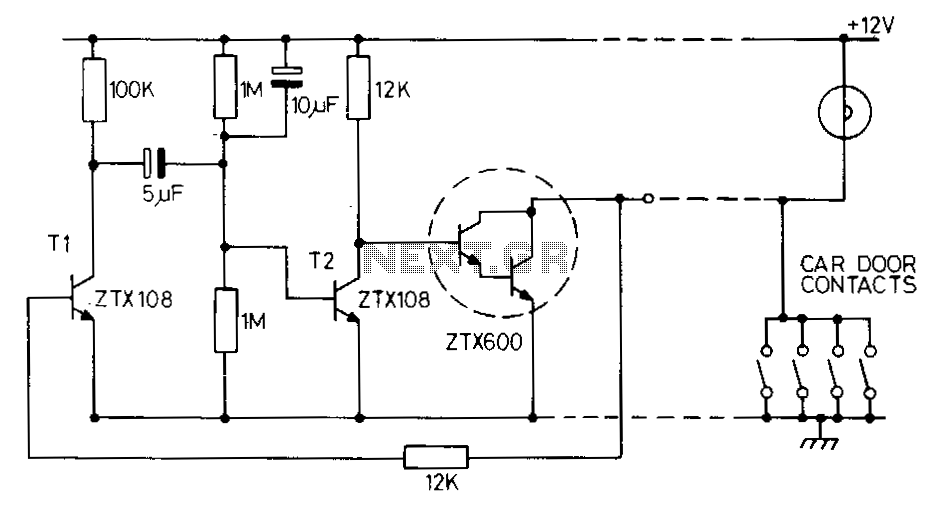
Courtesy-light-delay-switch

This circuit maintains the internal light for approximately one minute after the car doors are closed. When the door contacts open, a positive voltage pulse is applied to the base of transistor T1. This action activates T1, which in turn deactivates T2 and allows the charging of a 10 µF capacitor. Transistor T3 is then activated, keeping the internal light on. The capacitor discharges over the course of one minute when the circuit returns to its original state.
The circuit operates as a delay mechanism for the internal light in automotive applications, ensuring that the light remains illuminated for a specified duration after the doors are closed. The primary components include three transistors (T1, T2, and T3) and a capacitor (C1, rated at 10 µF).
When a car door is closed, the door contacts break the circuit, sending a positive voltage pulse to the base of T1. This pulse turns T1 on, allowing current to flow from the collector to the emitter, which subsequently turns off T2. With T2 deactivated, the path is cleared for C1 to charge. The charging of C1 creates a voltage across it, which is used to turn on T3. Once T3 is activated, it maintains the current flow to the internal light, keeping it illuminated.
The design of the circuit ensures that the internal light remains on for a duration of approximately one minute, as the capacitor C1 takes this time to discharge. The discharge rate is determined by the capacitor's value and the load presented by the internal light circuit. Once C1 has fully discharged, T3 turns off, ceasing the current to the internal light and returning the circuit to its original state.
This circuit is an example of a simple yet effective delay timer utilizing basic electronic components. It is particularly useful in enhancing user experience in vehicles, providing convenience and safety by ensuring visibility after exiting the vehicle.This circuit holds on the internal light for approximately one minute after the car doors are closed. When the door contacts open, a + VE pulse is applied to the base of Tl. This transistor turns on, turning off T2 and charging the 10-llF capacitor. T3 turns on, holding on the internal light. The capacitor takes one minute to discharge when the circuit reverts to its original state. 🔗 External reference
The circuit operates as a delay mechanism for the internal light in automotive applications, ensuring that the light remains illuminated for a specified duration after the doors are closed. The primary components include three transistors (T1, T2, and T3) and a capacitor (C1, rated at 10 µF).
When a car door is closed, the door contacts break the circuit, sending a positive voltage pulse to the base of T1. This pulse turns T1 on, allowing current to flow from the collector to the emitter, which subsequently turns off T2. With T2 deactivated, the path is cleared for C1 to charge. The charging of C1 creates a voltage across it, which is used to turn on T3. Once T3 is activated, it maintains the current flow to the internal light, keeping it illuminated.
The design of the circuit ensures that the internal light remains on for a duration of approximately one minute, as the capacitor C1 takes this time to discharge. The discharge rate is determined by the capacitor's value and the load presented by the internal light circuit. Once C1 has fully discharged, T3 turns off, ceasing the current to the internal light and returning the circuit to its original state.
This circuit is an example of a simple yet effective delay timer utilizing basic electronic components. It is particularly useful in enhancing user experience in vehicles, providing convenience and safety by ensuring visibility after exiting the vehicle.This circuit holds on the internal light for approximately one minute after the car doors are closed. When the door contacts open, a + VE pulse is applied to the base of Tl. This transistor turns on, turning off T2 and charging the 10-llF capacitor. T3 turns on, holding on the internal light. The capacitor takes one minute to discharge when the circuit reverts to its original state. 🔗 External reference